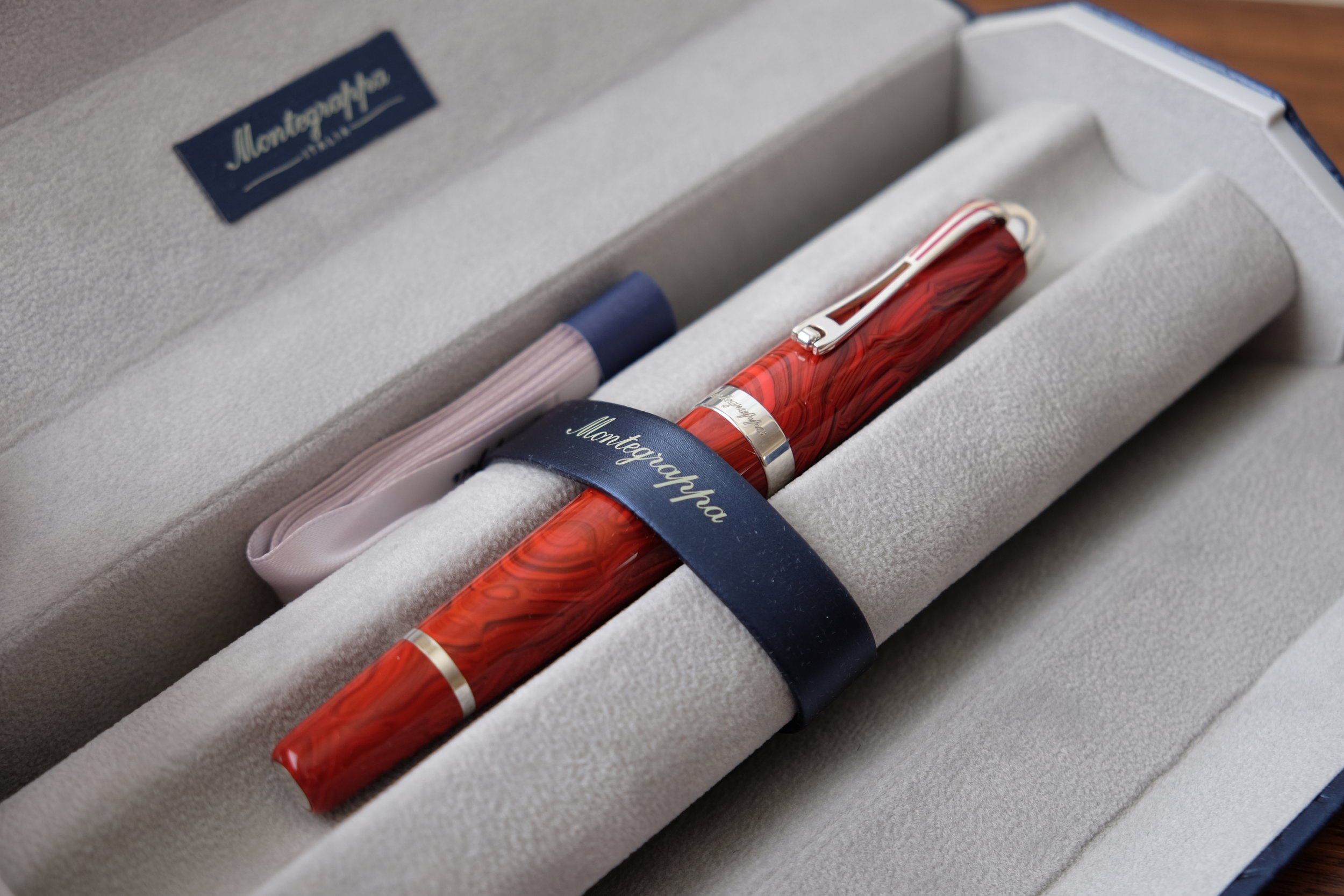You can probably guess how quickly I jumped at the chance to review this pen, the Montegrappa Passione. I've never owned a Montegrappa - prior to receiving this pen I'd never even written with one - so I had no idea what to expect. I came away impressed and looking to learn more about the brand.
Though their edgier, super-expensive limited editions like the "Pirates" and "Memory" pens tend to grab the most press, Montegrappa's more classic designs have developed a following among fountain pen fans. In recent years, the company has introduced the Fortuna series (in countless variants), as well as pens such as the Parola and the Ducale. All of these pens are vintage-inspired and good examples of what could be considered classic Italian pen design. The celluloid and sterling silver Passione is the latest entry into the Montegrappa lineup, and it's both visually stunning and an excellent writer.
Build
The Passione has all the hallmarks of a high-dollar pen that's worth what you pay for it: a sterling silver section and trim, celluloid, an 18k gold nib with an ebonite feed, and an understated design that is easily characterized as "timeless" rather than "trendy." Yes, this pen does have a metal section, which might rule it out for some people, but the the heft of the silver balances the lightweight celluloid nicely. It's an extremely well-balanced pen to write with, though I opted to use this pen unposted. Posted, I found the Passione a bit long and top-heavy, probably due to the sterling silver trim on the cap.
The "1912" finial on the cap ended up being one of my favorite features of this pen. Also, check out the red enamel inlay on the clip.
I'm always happy to see modern pen companies use celluloid, which is one of my favorite pen materials of all time and gives pens a vintage feel. This particular celluloid, which Montegrappa calls "Cinnamon," to me resembles red and black swirled ebonite. It's a very pretty material, and at some point I'd like to see the other Passione options in person: the pen is also available in Mediterranean Blue, Orange, and Zebra. Each celluloid has a different pattern. Zebra looks particularly stunning - you can check it out in Matt's review over at the Pen Habit.
The Passione sports a cartridge-converter filling system. While some people might balk at the lack of a piston filler at this price point, I honestly don't mind, and have come to prefer cartridge-converter pens overall due to the ease of cleaning, especially since I change inks often.
A close-up of the Passione Cinnamon celluloid, with Montegrappa's roller-clip and engraved cap band.
Nib and Writing Experience
The Passione is a great writer, period. Montegrappa uses relatively stiff 18k nibs - I'd compare the nib on this particular pen to an Aurora Optima nib, or maybe a Sailor. The Passione also features an ebonite feed, which can be heat-set to the nib to ensure steady ink flow. I'd characterize this nib as extremely smooth, moderately wet, and size-wise on the narrower side of medium. While the pen probably performs best on fountain-pen friendly paper, paired with a drier ink I wouldn't hesitate to carry this pen to work and use it as a daily driver.
Takeaways
If you're looking for a celluloid pen with an excellent nib, the Montegrappa Passione should be on your list of pens to try. It's an expensive pen, but it's made with expensive materials, and Montegrappa didn't cut any corners on the workmanship. In my opinion, you get what you pay for here. Whether the design appeals to you, of course, is always an issue of personal preference.
Time spent with the Passione has definitely increased my interest in Montegrappa as a brand. I've already placed an order for the Montegrappa Fortuna in white with ruthenium trim (the "stormtrooper" aesthetic), and I'm anxious to see how Montegrappa's steel nibs compare to their gold. While I'm not sure that I'll be picking up a Passione in the immediate future, it's not because I dislike the pen. Rather, I'm saving my money for one of Montegrappa's Flagship Extra 1930s in the Bamboo Black. (And I'll probably be saving for a while.)
Where to Buy
Montegrappa recently lowered the MSRP on the Passione to $795, with most retailers now listing the pen for just over $700. Nibs.com currently has all four colors of the Passione in stock and priced at $716. In case you're unfamiliar with the company, Nibs.com is owned and operated by master nibworker John Mottishaw, one of the best in the business. Every pen sold is set up and tuned to the purchaser's preference, and you even have the option of requesting a custom nib modification at checkout (for a supplemental charge). I've purchased pens from Nibs.com before and have always found their service to be top notch. They've also recently redesigned their website, making it much easier to navigate.
Disclaimer: Kenro Industries (Montegrappa's U.S. Distributor) loaned me this pen for review purposes. Though I contemplated keeping it and absconding to a remote island, I ultimately decided that I should send it back so Cary doesn't get in trouble.















